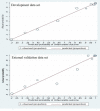Development and temporal external validation of a simple risk score tool for prediction of outcomes after severe head injury based on admission characteristics from level-1 trauma centre of India using retrospectively collected data
- PMID: 33455929
- PMCID: PMC7813344
- DOI: 10.1136/bmjopen-2020-040778
Development and temporal external validation of a simple risk score tool for prediction of outcomes after severe head injury based on admission characteristics from level-1 trauma centre of India using retrospectively collected data
Abstract
Objective: To develop and validate a simple risk scores chart to estimate the probability of poor outcomes in patients with severe head injury (HI).
Design: Retrospective.
Setting: Level-1, government-funded trauma centre, India.
Participants: Patients with severe HI admitted to the neurosurgery intensive care unit during 19 May 2010-31 December 2011 (n=946) for the model development and further, data from same centre with same inclusion criteria from 1 January 2012 to 31 July 2012 (n=284) for the external validation of the model.
Outcomes: In-hospital mortality and unfavourable outcome at 6 months.
Results: A total of 39.5% and 70.7% had in-hospital mortality and unfavourable outcome, respectively, in the development data set. The multivariable logistic regression analysis of routinely collected admission characteristics revealed that for in-hospital mortality, age (51-60, >60 years), motor score (1, 2, 4), pupillary reactivity (none), presence of hypotension, basal cistern effaced, traumatic subarachnoid haemorrhage/intraventricular haematoma and for unfavourable outcome, age (41-50, 51-60, >60 years), motor score (1-4), pupillary reactivity (none, one), unequal limb movement, presence of hypotension were the independent predictors as its 95% confidence interval (CI) of odds ratio (OR)_did not contain one. The discriminative ability (area under the receiver operating characteristic curve (95% CI)) of the score chart for in-hospital mortality and 6 months outcome was excellent in the development data set (0.890 (0.867 to 912) and 0.894 (0.869 to 0.918), respectively), internal validation data set using bootstrap resampling method (0.889 (0.867 to 909) and 0.893 (0.867 to 0.915), respectively) and external validation data set (0.871 (0.825 to 916) and 0.887 (0.842 to 0.932), respectively). Calibration showed good agreement between observed outcome rates and predicted risks in development and external validation data set (p>0.05).
Conclusion: For clinical decision making, we can use of these score charts in predicting outcomes in new patients with severe HI in India and similar settings.
Keywords: public health; statistics & research methods; trauma management.
© Author(s) (or their employer(s)) 2021. Re-use permitted under CC BY-NC. No commercial re-use. See rights and permissions. Published by BMJ.
Conflict of interest statement
Competing interests: None declared.
Figures







Similar articles
-
Prognostic models for prediction of outcomes after traumatic brain injury based on patients admission characteristics.Brain Inj. 2016;30(4):393-406. doi: 10.3109/02699052.2015.1113568. Epub 2016 Mar 22. Brain Inj. 2016. PMID: 27003280
-
Predicting outcome after traumatic brain injury: development and validation of a prognostic score based on admission characteristics.J Neurotrauma. 2005 Oct;22(10):1025-39. doi: 10.1089/neu.2005.22.1025. J Neurotrauma. 2005. PMID: 16238481
-
Predicting outcomes after traumatic brain injury: the development and validation of prognostic models based on admission characteristics.J Trauma Acute Care Surg. 2012 Jul;73(1):137-45. doi: 10.1097/TA.0b013e31824b00ac. J Trauma Acute Care Surg. 2012. PMID: 22743383
-
Validation of the geriatric trauma outcome scores in predicting outcomes of elderly trauma patients.Injury. 2021 Feb;52(2):154-159. doi: 10.1016/j.injury.2020.09.056. Epub 2020 Oct 5. Injury. 2021. PMID: 33082025
-
Predicting outcome after traumatic brain injury: development and international validation of prognostic scores based on admission characteristics.PLoS Med. 2008 Aug 5;5(8):e165; discussion e165. doi: 10.1371/journal.pmed.0050165. PLoS Med. 2008. PMID: 18684008 Free PMC article.
Cited by
-
Hypotension and Adverse Outcomes in Moderate to Severe Traumatic Brain Injury: A Systematic Review and Meta-Analysis.JAMA Netw Open. 2024 Nov 4;7(11):e2444465. doi: 10.1001/jamanetworkopen.2024.44465. JAMA Netw Open. 2024. PMID: 39527054 Free PMC article.
References
-
- WHO . World health report 2003-shaping the future. Geneva: Worald Health Organization, 2003.
MeSH terms
LinkOut - more resources
Full Text Sources
Other Literature Sources
Medical
